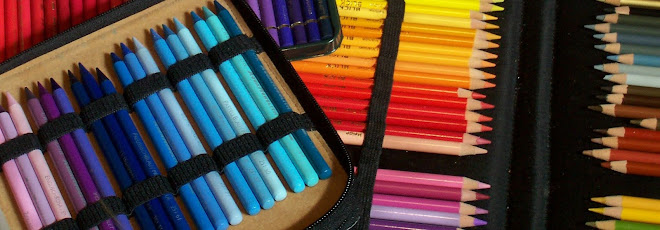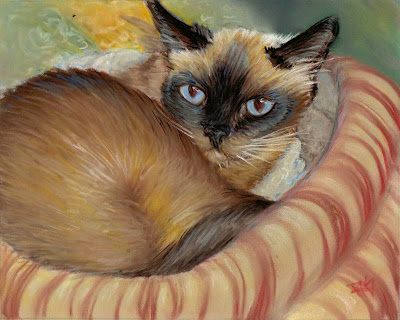
Masters Water-Soluble Pastel Sticks are a new product in an old category - semi-hard pastels. It's a little bit of a marketing trick that these inexpensive hard pastels are advertised as water-soluble when many brands of dry pastels are water soluble. Cretacolor Pastels Carre' are also watersoluble, Sennelier pastels are water soluble and most pastels will respond well to a water or alcohol wash in the first block-in layers of a pastel painting.
What these Masters Pastels offer for a beginner is decent quality, manufacturer's claim of lightfastness and water washability at a loony low price. Available in sets of 24 and 48, Jerry's Artarama carries these inexpensive hard pastels. The sticks are short compared to most brands, 2 3/8" rectangular sticks 1/4" wide. They look thick because they're so short, but they're a standard width. The 48 color set I bought to test was only $10.99 on sale at Jerry's.
Getting a big range for a low price is an important factor for beginners. If I was kitting up a student, these beat even the other low priced brands for getting more colors at less initial outlay. Their texture is very firm, there's a good range of darks, neutrals, skin tones and brights but very few tints or light colors. The white is going to wear down very fast and there's no ivory in the set, so I would supplement it with a Cretacolor Pastels Carre' white and perhaps an Ivory for lightening when you don't want to cool the underlying color.
One of the other ways the manufacturer cut prices is with inexpensive yet effective packaging. The box is unbleached, uncolored heavy cardboard, designed so that each piece has an indent on two sides. That makes it easy to lift out the top tray to get at the bottom 24 colors. There's a 1/8" thick pad of dense foam over the top tray and a sheet of wax paper over the second tray to keep the pastels clean and reduce dust migrating into other colors. The sticks are packed into thick dense slotted foam inside thin black cardboard trays. A heavy cardboard lid goes over the top, then a thin cardboard sleeve goes over the box to keep the lid from flying off.
By spending less on printing and colored pictures, the company's focused most of its resources on producing a decent product in a 6" square box sturdy enough to survive being knocked around in a backpack. I appreciate cost cutting that doesn't hurt quality and packaging that's usable in rough conditions for the life of the product.
I tested these over a washed Inktense underpainting. I was very pleased with how they performed. Similar to other hard pastels, they have a firm texture, blend well and mix easily once blended with fingers or sticks.

Of course that didn't tell me much about the product's big claim - that these sticks are water soluble. I decided to see how well they'd dissolve with another pears study. I deliberately scribbled loosely with distinct marks to see how well a good scrubbing would dissolve those marks.

So far, so good. They went on well over bare paper with good strong color. If I pressed hard I got strong distinct marks, just dragging the sticks lightly over the rough cream paper of my Stillman & Birn Delta journal produced good broken color.
Using a water brush, I scrubbed hard at all the marks, swirling the water around to dissolve everything as well as I could. I was happy with the results. Washing the Masters Pastels is as easy as washing any other water soluble pastel. They dissolve easily and didn't leave irritating specks of undissolved pastel or deep marks that didn't come up. If I wanted a lighter sketch and wash technique I would have to wash carefully to leave linear marks or redefine them by drawing into the wet area.

Then I finished my test painting working over the washed pears and background with the same Masters pastels. Just as with the Inktense underpainting, they covered easily and blended well. This time instead of the finger blending I used in some areas of the first test, I blended the background and pink covered table with the white stick to lighten my earlier scribbled marks. I used some complementary colors to tone the russet pear and the very bright green pear, mixing a mid-green with the lemon yellow to get the light yellow-green that wasn't in the set.
They do mix well enough to make up for any essential hues not in the set. There's no peach skin highlight stick, but white over any of the sanguine or russet colors will give a good skin highlight. Stick-blending and finger blending both work well. Colors are reasonably opaque, responding like other semi-hard and hard pastels.

My conclusion: Masters Water-Soluble Pastel Sticks are a good starter set for anyone thinking of trying soft pastels. These plus a 64 color Mungyo Gallery Standard Half-Sticks set will give a beginner a good range of colors plus a combination of firm and soft textures. When the paper tooth fills, switch to the Standard Half Sticks to add final details and accents. Working soft over hard extends how many layers you can use on non-sanded paper.
When you're ready to move up to using sanded and coated pastel papers and surfaces, consider buying a more expensive range of semi-hard pastels such as Mungyo, Richeson, Cretacolor, Sanford NuPastel or even the wonderful but expensive Faber-Castell Polychromos. However, even experts may benefit from having cheap and copious sketch supplies at a loony cheap price. There's something inspiring about not having to worry about cost even if you have to replace the whole set to get an extra white. It's easy to let yourself go and play like a kid.





